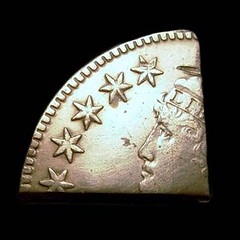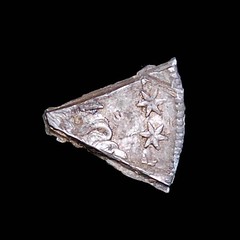
PREV ARTICLE
NEXT ARTICLE
FULL ISSUE
PREV FULL ISSUE
NEW BOOK: THE COINS OF FORT ATKINSON
Author Larry Lee forwarded this press release for his new book, The Coins of Fort Atkinson. Thanks!
-Editor
From the book’s abstract: “Although called both “a very exacting science” and “an academic discipline”, the field of numismatics as practiced in America has little recognized scholastic standing. While much of the rest of the world has national numismatic museums and coin cabinets curated by recognized academic scholars, America apparently only has hobbyists and charlatans on late night TV. The lack of perceived value for numismatics is particularly apparent in the archeology of the Great Plains, where the indigenous economy was not based on bullion value, where coin hoards like those found on the eastern seaboard are basically non-existent and where coins and other numismatic items are considered to be ‘historic’ and thus intrusive to the prehistory of the region. In such a setting, any numismatic finds are often casually and inexactly described, poorly photographed and left uninterpreted as to cultural meaning or context. After reviewing the inexact manner in which coin finds have been handled at several Plains archeology sites, this paper reexamines a published, excavated historic site in Nebraska in order to demonstrate the depth and insight a careful re-analysis of numismatic material can add to a site’s cultural as well as historic interpretation. Fort Atkinson was at the time of its service (1819-1827) the westernmost fort in America and the earliest settlement in what is now Nebraska. It had a complex, interconnected economy that included fur trade, barter, bullion specie (including coins from many countries and mints as well as U.S. coinage), credit, lay-away plans, soldier certificates, Treasury warrants, Treasury notes, bank drafts, checks and bonds. Over one hundred and twenty coins and coin ‘bits’ were recovered from Fort Atkinson during ten seasons of excavation. This book for the first time describes all of the individual coins from a numismatic perspective that adds significantly to the understanding of life on the military frontier and will hopefully serve as a reference tool for future archeological discoveries of numismatic items in the Great Plains region.”
As an extension of his 2006 doctoral dissertation on numismatic education in the United States, Lee notes that the research is significant for several reasons. Not only is it an analysis of the coins and coin bits from an important early American historic site with multiple economies, but the book also serves as an example of the methodological structure that all standardized numismatic research needs to follow to be academically relevant: statement of the problem; review of the literature; data collection; data analysis and conclusions and recommendations.
Carl Wolf of Chicago was a reader of an advanced copy of the manuscript and also listened to a presentation Lee gave on Fort Atkinson to the Chicago Coin Club back in October. Wolf wrote “Coin stories with an archeological perspective are always fascinating. However, most are based on coin hoards discovered in Europe or Asia. This story springs from the American frontier, today's Midwest. Lee's research into the history of Fort Atkinson and the coins uncovered among its ruins has set a high bar on numismatic archaeology. I was one of the fortunate few who read a draft of the work. I admire Lee's talented writing style; his storytelling is concise and complete.” Dr. Lee will be in Chicago for the Central States Numismatic Show on April 22 and 23, doing a book signing at noon on both days. CSNS provided the grant that funded Lee’s research. The book The Coins of Fort Atkinson is priced at $24.95 plus $2.95 postage ($27.90 total) and is available exclusively from Deibus Noe Publishing, P.O. Box 6171, Lincoln, NE 68506. Nebraska residents must add an additional 7% sales tax on each book. Payment can be made by check or money order, no credit cards accepted. PayPal may be an option. There is a publisher’s discount for orders of 10 or more copies. Lee can be contacted at lee@athena.csdco.com. In the "actually-a-coin-WAS-harmed-in-making-this" department, Larry adds: That one American bit is pretty special in that it took two whacks with the hatchet to chop it, then it had to be folded back and forth on the crevice to totally crack apart. The coin is basically uncirculated and those edges are still razor sharp.
Ouch! Most numismatists are familiar with the practice of dividing Spanish dollars into eight slivers or "bits". With eight bits to the dollar, two bits equal a quarter, and a single bit is 12 1/2 cents. These fractions circulated widely in the United States and all such foreign coins were legal tender until 1857, explaining the paper money denominations of 6 1/4 cents (half bit), 12 1/2 cents (bit) .and even 37 1/2 cents (3 bits) . Chopping U.S. coins into bits is a much less common practice, but one necessitated here by the Fort's remote location. This is a fascinating aspect of American history, and I look forward to reading the book. Can anyone tell us where to find other illustrations of American coins chopped to bits for change? Where else in the U.S. have these been found at archeological sites?
-Editor
THE BOOK BAZARREWayne Homren, Editor The Numismatic Bibliomania Society is a non-profit organization promoting numismatic literature. See our web site at coinbooks.org. To submit items for publication in The E-Sylum, write to the Editor at this address: whomren@gmail.com To subscribe go to: https://my.binhost.com/lists/listinfo/esylum All Rights Reserved. NBS Home Page Contact the NBS webmaster 
|


